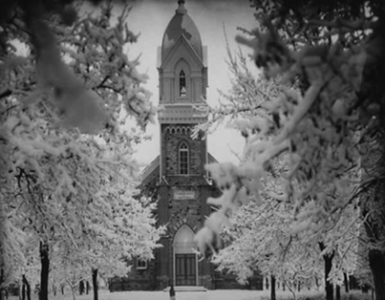Action taken at the October 1853 LDS Conference had a great impact on Brigham City’s future growth. Lorenzo Snow, a member of the Quorum of Twelve Apostles, was called by Brigham Young to select 50 families to move to Box Elder to strengthen the settlement. They had the winter to provision themselves for the move north the following summer.Fredereick M. Huchel, A History of Box Elder County, (Salt Lake City: Utah State Historical Society, 1999), 69. Snow came north to look over the site, but did not move his family until he could provide them with a home, later noting his first impression:
“When I arrived in Box Elder County, I found the location where Brigham City now flourishes in a very unprosperous condition. Whether its change from a primitive state should be called improvement, i.e., whether it was better or worse for what had been done on the premises, would puzzle an antiquarian. Even the log meeting house, with its ground floor and earth roof, was more extensively patronized as a receptacle for bed bugs than for the assemblage of saints.”Eliza R. Snow Smith, Biography and Family Record of Lorenzo Snow, (Salt Lake City: Deseret News Company, 1884), 261.
With more settlers anticipated, territorial surveyor Jesse W. Fox was called in February 1854 to survey the “Big Field” at Box Elder (the area north and west of the fort) dividing the large farms into smaller parcels, mostly into five-acre lots. The pioneers were promised blessings if they would divide their land and water with the newcomers who were being sent to build up the settlement.Nielson, Vaughn, and Church of Jesus Christ of Latter Day Saints, The History of Box Elder Stake: written in commemoration of the hundredth anniversary of Brigham Young’s setting in order a state for Box Elder County, (Brigham City: Box Elder Stake, 1977), 5.
The Box Elder settlement grew considerably during the spring and summer of 1854 as the fifty “called” families gradually arrived, as did a second Scandinavian company. It was at this time that the fort was extended at the south end, and most settled there or nearby for the winter.
A sawed log school house was built at the southeast corner of the extension and it was also used for community gatherings. Before construction of the schoolhouse, such activities were held either in the open central area or in the cabins of settlers. The home of Bishop Davis was used for church services, school classes were held by Henry Evans in different homes, and people danced to violin music played by George Hamson and Owen (Blind) Jones in Mr. Hutchson’s house.Lydia Walker Forsgren, History of Box Elder County, (Brigham City: Daughters of Utah Pioneers, 1937), 218.
Lumber for building was one of the first needs, so in 1854 an up-and-down saw (also known as a pit saw) was built near the fort for communal use. This was an oblong pit about six feet deep, with a frame holding four or six floor logs, upon which the log to be sawed could be laid. Two men then used a large rip saw with handles on each end. David Lewis, a Welshman, cut pine shingles from the scraps with his knife.Ibid., 218.
The schoolhouse was part of Brigham City’s first celebration, held on July 24, 1854. Since the center of the newly platted city and the fort were separated by bunch grass, the settlers made a road to the site and erected a bowery. Young men and maidens, attired in their best, formed lines and marched two abreast to the scene of the festivities, led by Porter Squires carrying a banner. At the bowery, they sang and listened to Lorenzo Snow. After a dinner was served, the bowery was cleaned and all enjoyed themselves dancing until “chore time.”
“In the evening they took a picnic supper and held a dance in the long log school house located just outside of the fort limits. The hall was lighted with candles placed in rows on the window ledge. Both young and old were in attendance.”Ibid., 182.
Apostle Wilford Woodruff traveled to visit northern settlements in late 1854, and on December 4, 1854, he recorded in his journal:
“I rode to Box Elder & preached in the evening at the School House. This place contains 60 families Brother Davis Bishop. The majority of the people are Welsh and Danish and mostly poor.”Nielson, Vaughn, and Church of Jesus Christ of Latter Day Saints, The History of Box Elder Stake: written in commemoration of the hundredth anniversary of Brigham Young’s setting in order a state for Box Elder County, (Brigham City: Box Elder Stake, 1977), 6.
Although Brigham Young encouraged assimilation of various nationalities and encouraged use of English in church meetings, there were both religious and social gatherings in which the Welsh and Scandinavians met exclusively and used their native languages. On occasion, this would cause some annoyance between the settlers, but their common religion and pioneer experiences usually overcame these differences.


Add comment